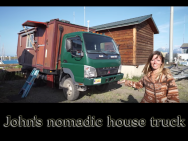American architect and designer Meg Stevens was “immediately hooked” on tiny houses when she discovered them five years ago. She set a plan in motion to design and build her own tiny house – which was realized last year when she moved into The Lucky Linden, a tiny house RV measuring about 170 square feet.
Meg grew up in Michigan in a neighborhood under construction. Spending her spare time helping her dad with building projects, her interest in architecture, design and building was piqued at an early age. When she became interested in tiny houses in 2013, she purchased a ticket to a workshop at Tumbleweed Tiny House Company, an organisation focused on designing tiny house RVs, in order to learn more about the process. She ended up being hired as an architect, and her Lucky Linden RV design is one she created for the company – with a few changes made to suit her (and her husband Dan’s) personal living style.
“We decided to build a tiny house about five years ago, and immediately started planning (and saving up money),” Meg said. “We didn’t want to go into debt for the house, so I would work on the build as we had the funds, and put it into storage while saving up for the next phase. It took three years to build this way, and it was in storage for stretches of time from six months to over a year.”
“While we were building, we gradually downsized until we were living in a 330 sq ft studio apartment,” she said. “The apartment was just a bit over double the size of the tiny house, so when we finally finished the build and moved in to the tiny house it wasn’t much of an adjustment at all. We love it!”
Tiny houses can be anything smaller than the normal for family size, according to Meg. A four-person family living in a 600 sq ft house is tiny, because there is only 250 sq ft per person. But conventionally – at least in terms of the growing Tiny House Movement across the US – a tiny house is between 100 and 400 sq ft. And the majority of them are built for off-grid living.
Meg, a prominent member of the Tiny House Movement – a community of like-minded individuals across the US advocating tiny houses as energy efficient living spaces – says the American tiny house community has experienced “rapid, almost exponential growth” in the last four years, owing to environmental concerns, financial issues as the cost of living rises, and the desire for more time and freedom.
“Designing especially is more difficult in a small space, but it’s rewarding. Efficiency is everything, and really considering ‘needs’ vs ‘wants’ vs ‘nice-to-haves,’” Meg said.
“Tiny houses are more energy efficient just because of their size, but also I think the general …



